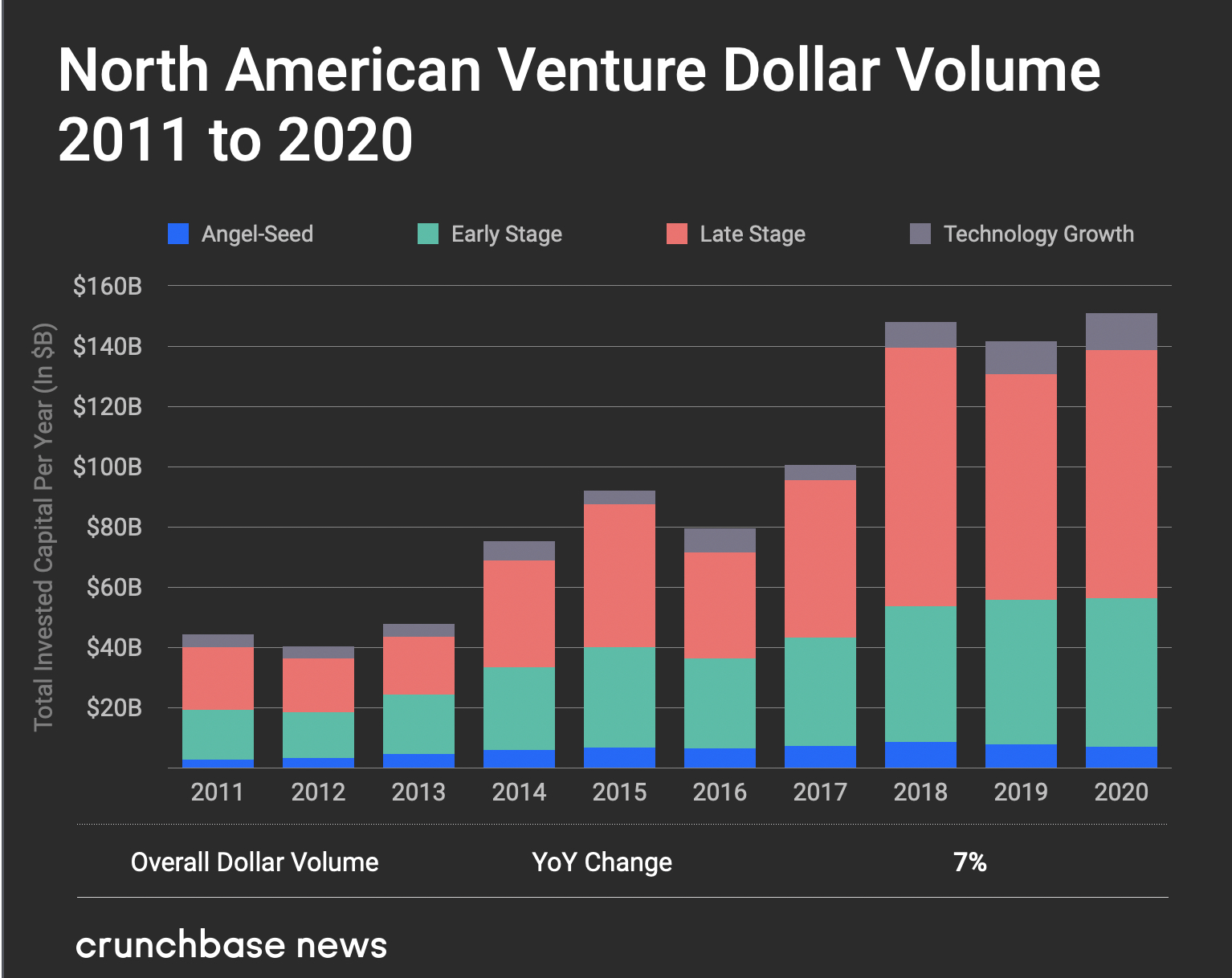History will remember 2020 as a very bad year by many measures. However, venture funding will not be one of them.
Subscribe to the Crunchbase Daily
Funding for startups and growth-stage private companies in North America held up at historically high levels last year. Even amid a pandemic, widespread unemployment, and escalating small-business closures, investment was up year over year across all stages from early and beyond.
Table of contents
North America overall
Overall, venture investors put just over $150 billion to work across all stages in 2020, up around 7 percent from 2019 levels, per Crunchbase data. For perspective, here are the annual funding totals, color-coded by stage, for the past 10 years:
The fourth quarter ended on a robust note as well. Investors poured $38.7 billion into North American seed- through growth-stage deals in Q4, per Crunchbase data. Totals for Q4 of 2020 were up 16 percent year over year and down 12 percent quarter over quarter.


The narrative playing out in the private company sphere largely dovetailed the public market environment. COVID-19, political mayhem and financial distress on Main Street failed to resonate on Wall Street, with major indexes, and tech stocks in particular, reaching record valuations.
The upbeat climate on public exchanges helped spur a raft of venture-backed unicorns to carry out initial public offerings and direct listings, and follow the increasingly popular special purpose acquisition company path to market debuts. Those hitting public markets in Q4 were among the largest debuts of the year, led by Airbnb and DoorDash.
Below, we look at the tallies by stage, highlight top exits, and look at the most active investors for both the year and the just-ended quarter.
Late-stage funding
Late stage accounts for the largest share of venture dollars across any stage, so we’ll start there.
For all of 2020, venture investors put $94.5 billion into late-stage and technology growth1 deals. That’s a sizable jump from 2019, when $85.7 billion went into such deals.
While funding rose, round counts declined a bit. Crunchbase counted 1,167 late-stage and tech-growth rounds in 2020, down 10 percent from 2019, as average round sizes grew larger. In the chart below, we lay out funding totals and round counts for the past five quarters.


The fourth quarter was the second-biggest of the year for investment totals, with $23.3 billion going to late-stage and technology-growth deals. That’s down 25 percent from Q3, which was by far the biggest quarter of 2020, but up about 18 percent from the year-ago quarter.
For both Q4 and 2020 as a whole, supergiant rounds of $100 million or more played a key role in pushing investment totals up. For the full year, there were 193 so-called supergiant rounds of $100 million and up at the late stage, per Crunchbase data, up from 156 in 2019.
The brisk pace of supergiant late-stage rounds continued in Q4, with five late-stage rounds of $340 million and up:
- Nuro, a developer of autonomous delivery vehicles, raised a $500 million Series C;
- Relativity Space, which focuses on 3D printed rockets, raised a $500 million Series D;
- TuSimple, a self-driving truck company, raised a $350 million Series E; and
- Scopely, a mobile gaming company raised a $340 million Series E.
For the full year, meanwhile, there were 26 late stage rounds of $300 million and up, with the largest—a $600 million Series E—going to payments processor Stripe.
Early-stage funding
Early-stage investment also rose in 2020, with Q4 ending the year on a high note.
For the full year, investors put $49.1 billion into early-stage rounds (Series A and B), up about 3 percent from the 2019 total. Round counts totaled just under 3,000, down around 11 percent from 2019.
The fourth quarter provided a strong close, with $13.6 billion in early-stage investment, the highest total of the past five quarters. Round counts, meanwhile, were up slightly quarter over quarter, but still down from year-ago levels. We lay the numbers out in more detail in the chart below.


In the fourth quarter in particular, we saw a proliferation of super-sized Series A and B rounds. These include:
- Resilience, a startup looking to speed up the biopharmaceutical manufacturing process, raised $750 million in a November Series B round;
- Uber Freight, a logistics spinout of Uber, raised $500 million in an October Series A round;
- Heyday, a digital marketplace for consumer products brands, raised a $175 million Series A round in November; and
- Function of Beauty, a provider of customizable beauty products, raised $150 million in a December Series B round.
Seed-stage funding
Seed-stage investment was down in 2020 compared to year-ago levels, and hit a low point in the fourth quarter, according to reported data from Crunchbase.
Overall, seed-stage companies raised $7.2 billion in all of 2020, down 10 percent from 2019. Reported round counts totaled just over 6,400, down 22 percent from 2019 levels.
For Q4, meanwhile, seed investment totaled $1.7 billion, tied for the lowest total in two years, while round counts saw steep year-over-year declines. Investment totals and round counts for the past five quarters are shown below.


Part of the Q4 and 2020 seed-stage declines may be attributed to reporting delays. Much of the seed funding data in the Crunchbase dataset is self-reported by companies. Because a sizable percentage of rounds get entered weeks or months after they close, reported funding totals historically rise over time.
That said, it does appear that seed and angel funding was down some, even accounting for the lag. It’s a trend likely attributable in part to the pandemic. After all, it was not an opportune year to launch a startup in a number of spaces, including travel, hospitality and live entertainment. Investors and founders in a range of sectors may also have taken a wait-and-see approach, preferring to launch and scale in a post-pandemic environment.
The absence of face-to-face networking opportunities probably also played a role. Investment for seed companies is more personality-driven than at other stages, since startups typically have no finished product or market traction.
Exits
Overall, 2020 was an exceptionally good year for venture-backed exits, and Q4 was a standout quarter on this front. Below we look at returns from public market debuts, followed by M&A.
IPOs, Direct Listings And SPACs
The tech sector was on fire in the public markets last year, and startups took notice. Many companies that had been talked-about candidates for public listing chose 2020 as the year to make it happen.
Markets were receptive. The year’s biggest tech market debuts included Airbnb, Palantir, DoorDash, and Snowflake, which now collectively maintain a market capitalization of over $300 billion.
Many of the year’s largest market debuts took place in Q4, as laid out in the following list.


In addition to the size and volume of public offerings, 2020 stands out for the variety of methods companies employed to make their market debuts.
While most of the largest offerings were traditional IPOs, we also saw heightened use of two other paths to the markets: direct listings and mergers with a special purpose acquisition company, or SPAC.
For 2020, the largest direct listing was Palantir, which went public in late September at an initial valuation of $22 billion and has since seen its market cap balloon to $49 billion. On the SPAC side, homebuying and selling platform Opendoor closed out the year with a December debut at an $18 billion valuation following completion of its merger with a blank-check acquirer.
M&A
Venture-backed companies also got acquired at a pretty good clip in 2020, with a number of multibillion-dollar deals, including several in the fourth quarter.
Standout M&A deals for 2020 include Illumina’s $8 billion purchase of cancer screening company Grail in September and Intuit’s $7.1 billion purchase of fintech unicorn Credit Karma, which was announced in February and completed in December.
As for Q4, we saw a dozen acquisitions2 valued at $1 billion or more, with the largest of the disclosed deals listed below.


Active Investors
As mature startups exited, younger companies lined up for fresh venture funding, and an array of prominent VC firms stepped up with capital.
Below we look at the most active venture and alternative investors in Q4 of 2020, looking at both new investments and follow-on investments in existing portfolio companies.


We don’t see any big surprises here, although it’s notable that the list does favor companies active in late-stage investment and multistage investment rather than pure early-stage investors.
The Big Picture
So, having crunched the numbers, with what sweeping description may we bid adieu to 2020?
Overall, it was a bullish year for venture funding and exits amidst a grim period in many other respects.
For 2021, startups are certainly hoping the receptive public markets, readily available capital, and strong valuations remain a thing. However, it’d also be nice to see a return of some of the much-missed aspects of startup life, including a lot fewer video meetings and a lot more face-to-face human contact.
Methodology
The data contained in this report comes directly from Crunchbase, and is based on reported data for North America namely Canada and the United States.
The most recent quarter will increase over time relative to previous quarters. For funding counts, we notice a strong data lag, especially at the seed and early stages, by as much as 26 percent to 41 percent a year out.
Please note that all funding values are given in U.S. dollars unless otherwise noted. Crunchbase converts foreign currencies to U.S. dollars at the prevailing spot rate from the date funding rounds, acquisitions, IPOs and other financial events are reported. Even if those events were added to Crunchbase long after the event was announced, foreign currency transactions are converted at the historic spot price.
Glossary of funding terms
- Seed and angel consists of seed, pre-seed and angel rounds. Crunchbase also includes venture rounds of unknown series, equity crowdfunding, and convertible notes at $3 million (USD or as-converted USD equivalent) or less.
- Early-stage consists of Series A and Series B rounds, as well as other round types. Crunchbase includes venture rounds of unknown series, corporate venture, and other rounds above $3 million, and those less than or equal to $15 million.
- Late-stage consists of Series C, Series D, Series E and later-lettered venture rounds following the “Series [Letter]” naming convention. Also included are venture rounds of unknown series, corporate venture, and other rounds above $15 million.
- Technology growth is a private equity round raised by a company that has previously raised a “venture” round. (So basically, any round from the previously defined stages.)
Illustration: Dom Guzman


Stay up to date with recent funding rounds, acquisitions, and more with the
Crunchbase Daily.











